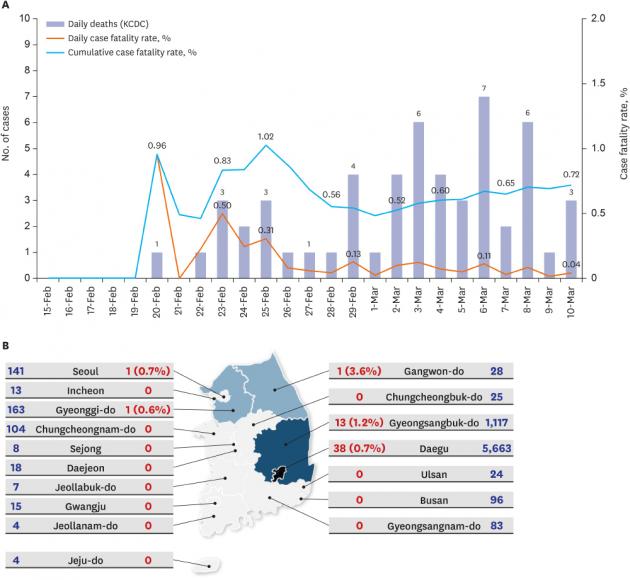The Korea Centers for Disease Control and Prevention said that the mortality rate of the new coronavirus soars among patients aged 70 or more and have underlying diseases.
The KCDC reaffirmed the fact in a recent report that analyzed the epidemiological and clinical features of the first 54 COVID-19 fatality cases in Korea.
“Since Korea detected the first case of COVID-19 on Jan. 20, the global number of confirmed cases as of March 15, reached 156,400, with total death of 5,833 (3.7 percent) worldwide," the report said. "To give a detailed comparison for Korea, we analyzed the mortality data of 54 deceased patients when the total number of COVID-19 patients in Korea totaled 7,513 as of March 10."

According to the report, during the first week after the first morality case, the daily case fatality rate (CFR) was 1.22 percent. However, the rate plunged to 0.04 percent on March 10, resulting in a cumulative CFR of 0.7 percent. The median age at death was 75.5 years, and men accounted for 61.1 percent of total deaths.
Also, 90.7 percent of the patients had an underlying illness, and the most common underlying illness was cardiovascular disease, such as hypertension and heart diseases, followed by diabetes, and neurologic diseases.
The CFR of men, which stood at 1.16 percent, was also higher than that of women, with 0.45 percent. The gender gap in CFR was more evident in the age group of 60 years or older, with men showing 4.73 percent against women’s 1.88 percent.

Regarding underlying illness, there were eight immunocompromised patients, seven cancer patients, one kidney transplant recipient, seven patients with the psychologic disease.
"The high proportion of patients with mental problems was due to the cluster infections among chronic psychologic patients at a mental ward of Daenam Hospital in North Gyeongsang Province where a religious group’s leader had his family funeral," the report said. "The Shincheonji sect was later found to be the main cause of COVID-19 surge in Daegu and its surrounding province."
The report also analyzed survival time from the onset of symptoms to death in 31 patients.
"Among the 31 patients with whom the dates of symptom onset were available, the median days from symptom appearance to death was 10 days," the report said. "Duration from symptom onset to death was not different between men and women or among different age groups. Nor was there any difference between the patients with underlying illness and those without."
However, it is noteworthy that all three patients without underlying illness were alive until the 10th day of showing symptoms, the report added.
The report stressed that mortality is the most critical factor when dealing with the unexpected outbreak of infectious diseases and setting up priorities to control the epidemics.
"Under outbreak circumstances, maintaining the healthcare system is the key, especially when there is a rapid surge in the number of confirmed cases in the community," the agency noted. "The most important strategy is to keep the hospitals' capacity to treat severe patients from the early phase through careful and proper triage and maintain the healthcare system."
The agency stressed the need for more studies in a more substantial way to understand COVID-19 mortality more accurately.
The results of the research were published in the Journal of Korean Medical Science, titled the “Analysis on 54 Mortality Cases of Coronavirus Disease 2019 in the Republic of Korea from Jan. 19 to March 10, 2020."

